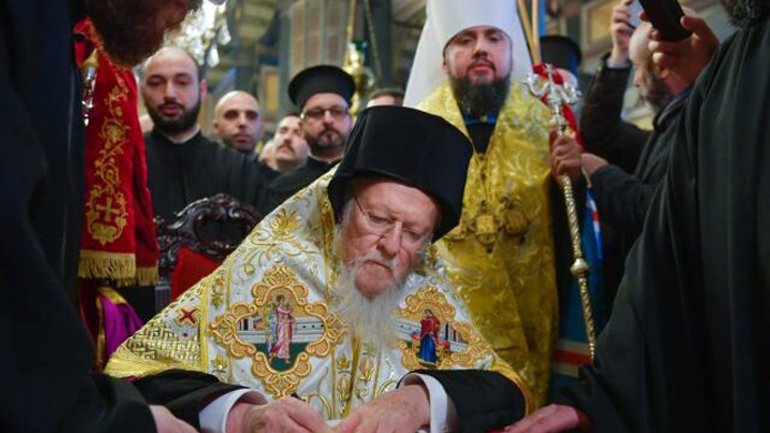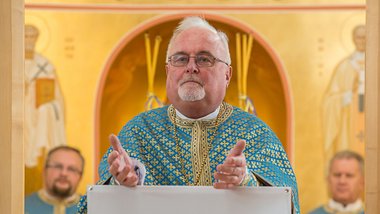332-year pan-Orthodox church conscience for Orthodox Church of Ukraine

The territorial boundaries of each Patriarchate and each Autocephalous Church are defined in the Tomoi granted by the Ecumenical Patriarchate. Thus, the boundaries of the canonical jurisdiction of the Russian Patriarchate were defined according to the territorial boundaries of the Kingdom of Greater Russia and the far northern parts of 1589. The church tradition of two millennia gives content to the strict canonical description of both the territorial boundaries of each Autocephalous Church, and the consequences of any arbitrary or non-canonical transgression.
Patriarch Joachim of Moscow and Tsar Peter the Great asked the Ecumenical Patriarch Dionysios IV to bring the new areas under the jurisdiction of the Russian Patriarchate. The Ecumenical Patriarch, of course, rejected the request and instead, by virtue of the Synodal Act of 1686, granted to the Patriarch of Moscow “economically” the “permission” to ordain and enthrone the Metropolitan of Kyiv elected by the clergy-laity assembly, subject however to the condition that the Metropolitan of Kyiv will commemorate the Ecumenical Patriarch in every Divine Liturgy. The commemoration of the Ecumenical Patriarch ensured the inviolability of the canonical exarch jurisdiction of the Ecumenical Patriarchate throughout the Kyiv Metropolis.
The syntagmatia referred to by the Russian Patriarchate can in no case have the validity of a Tomos or a Synodal Act. After all, the Russians themselves did not take them into account since, in its reply letter to the invitation of Ecumenical Patriarch Gregory VI (1868) for the Great Synod to be convened in Constantinople to deal with the Bulgarian issue, the Holy Synod of the Church of Russia “said that Kyiv is the most neutral place for this matter.” In other words, he did not consider the Kyiv Metropolis to be an area under its jurisdiction, according to the syntagmatia, but a “neutral area.”
The failure by the Russian Patriarchate to comply with the obligations provided for the 1686 Synodal Act was pointed out in a strong way in the Autocephaly Tomos of the Polish Orthodox Church in 1924, where it becomes clear what had happened; “it is written that the initial detachment of the Metropolis of Kyiv from our Throne and its dependencies, Orthodox Churches of Lithuania and of Poland, and their attachment to the Holy Church of Moscow was not carried out in accordance with the canonical regulations while the agreement on the full autonomy of Metropolitan of Kyiv with the title of Exarch of the Ecumenical Throne was not respected.” The proclamation of the Autocephaly of the Polish Orthodox Church by the Ecumenical Patriarchate confirmed the canonical status of the Patriarchal Exarchate of the Kyiv Metropolis and excluded any legal relationship with the Russian Patriarchate before or after 1686 Synodal Act. It is noteworthy that, although at first, the Russian Patriarchate refused to recognize the autocephaly of the Polish Orthodox Church, in 1948 it recognized and accepted everything that was stated in the Tomos, like all other Autocephalous Orthodox Churches had done before. Therefore, the claim that, according to the pan-Orthodox church conscience, Ukraine belonged to the Russian Orthodox Church is unfounded. If this were the case, no Church would recognize the autocephaly of the Polish Orthodox Church or ask that this reference in the Tomos be changed as false. It is clear that the Tomos of the Polish Orthodox Church asserted that the Ecumenical Patriarchate never considered that, by the virtue of the 1686 Synod Act, it conceded Ukraine under the jurisdiction of the Russian Patriarchate.
Shortly before the dissolution of the Soviet Union and the independence of Ukraine, the Russian Patriarchate realized the imminent danger of losing control of the Orthodox Church in Ukraine because it could not ignore the long-standing and uncompromising demand of the Ukrainian people for full independence of this. Thus, in 1990 Patriarch Alexy II of Moscow gave the Tomos to Metropolitan Filaret of Kyiv with which he granted self-government to the Church of Ukraine with rights of wide autonomy. Then the current “Ukrainian Orthodox Church of the Moscow Patriarchate” was established. So its history is only 30 years. Then, for the first time, the title of Metropolitan of Kyiv and all Ukraine was illegally given to its primate (this title was held until the Unification council of the Eastern Orthodox churches of Ukraine in December 2018 when it was given to the primate of the new Autocephalous Church). The Russian Patriarchate wanted in this way to absorb the Church of Ukraine so that the issue of autocephaly would not be raised, thus losing any influence it would have on it. However, in the conscience of Ukrainians, this was not tolerated. Thus, in 1992 the entire hierarchy of the Autonomous Church of Ukraine unanimously signed the request for Autocephaly. However, the request was wrongly made to the Russian Patriarchate and not to the Ecumenical Patriarchate because it had received the Tomos of Self-Government two years earlier from the Russian Patriarchate it did not want to provoke the expected reactions. The Russian Patriarchate immediately rejected it and called for Metropolitan Filaret of Kyiv to resign immediately. After refusing to resign, the Russian Patriarchate dismissed him and replaced him with Metropolitan Vladimir. That was the reason for his dismissal. The Russian Patriarchate has always rejected anything related to the Ukrainian Church’s Autocephaly and condemned all its supporters for obstructing its plans to claim the jurisdiction of the Orthodox Church in Ukraine. This resulted in the splitting of the Hierarchy of the Church of Ukraine into advocates and opponents of the autocephaly.
Metropolitan Filaret of Kyiv did not expect such a development and immediately appealed to the Ecumenical Patriarchate. However, the Ecumenical Patriarch very wisely did not accept the request, because he wanted a peaceful solution to the problem with the consent of all parties, so that there would be no disputes in the Church. He repeatedly asked the Russian Patriarchate to resolve the issue of Ukraine, starting a dialogue with the other side. This was the wish of all the local Churches, even though they all recognized only the Autonomous Church of Ukraine of the Russian Patriarchate, waiting for the Russian side to provide the solution. But the Russian Patriarchate had no such intention. On the contrary, a methodical and systematic effort has been made over the last twenty-five years to impose only pro-Russian Bishops on Ukraine and to bring the Ukrainian Orthodox Church under its jurisdiction from within. It is worth mentioning that at the Hierarchical Synod where the Autocephaly had been requested (1992), there were 26 Bishops who had signed in favour of the Autocephaly (along with those who later seceded). Today there are over 80 Archbishops of the Church of the Russian Patriarchate in Ukraine. And as a natural result many parishes were created and many Monasteries were manned, so that there is a measurable resistance to any claim of Autocephaly by the advocates of the Ukrainian High Priests. That is why one of the arguments we often hear from the Church of Russia is the number of parishes, monasteries and clergy.
The Patriarch of Moscow, in 2000, illegally included in the new Charter of the Church of Russia the “autonomous Churches” of Ukraine, Belarus, Moldova and Estonia, relegating them to mere “self-governing Churches” in order to include them under his jurisdiction and arbitrarily characterize them as his normal territory.
The Ecumenical Patriarch insisted that the issue should be resolved, and in 2008 met with Patriarch Alexy II of Moscow at the Monastery of the Caves in Kyiv in order to discuss the serious issue of the Ukrainian Orthodox Church’s Autocephaly. The meeting was also attended by Metropolitan Kirill of Smolensk, the current Patriarch of Russia. In these discussions, the two Patriarchs agreed that this issue was very serious and extremely urgent and that they should act immediately and jointly as soon as possible. Therefore, the new Patriarch Kirill, although he knew the agreement of the two Patriarchs, instead chose the idea of a final deterrent to the proclamation of the Autocephaly of the Church of Ukraine. As a result of this stance, the Patriarch of Moscow at the last Meeting of the Prelates (Sambezi 2016) before the Holy and Great Council of the Orthodox Church, asked the Ecumenical Patriarch not to raise the issue of Autocephaly of the Church of Ukraine in the Great Council neither before nor during the sessions, nor after the end of the work of the Great Council, as a necessary condition for the Russian Patriarchate to consent to its convening.
The situation in Ukraine could not continue as it was, especially after 2014 when Crimea was annexed to Russia and the war in Donbass began. No country can accept its Church to be dependent on a country with which is at war. The aim was to cure a condition in which more than half of the Orthodox population was considered schismatic. For 27 years an Orthodox in Ukraine had two choices, either to belong to the Russian Patriarchate or to one of the schismatic groups. If he joined one of them, the salvation of his soul was in danger. After the outbreak of the war, the choice became a heavy burden on the conscience of many who, while not wanting to have any spiritual dependence on Russia, wished to belong to a canonically recognized Church. How can the Hierarchs of the Church of Russia in Ukraine look into the eyes of so many orthodox Ukrainians who let them remain unjustly divided?
By Hieromonk Nikitas of Pantokratoros Monastery









